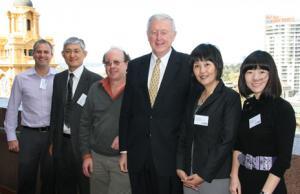
Efforts by industrialised nations to shift to clean technology were in the spotlight at an international conference at Victoria University last week.
Interest was focused on China, whose reliance on fossil fuels is well documented as it cements its role as the world's leading production house.
Research director of China's Energy Research Institute Dr Jiang Kejun told the conference that his country would experiment with a variety of methods to curb carbon emissions during pilot programs over the next few years.
He told The Age last week that the Australian scheme of a fixed carbon price leading to a cap and trade program was one model his country would use in regional pilots.
The rapid Chinese development of clean technology accompanying fossil-fuel based production was a strong feature of the conference. Manufacturing of solar panels, for example, is now a major export industry in China. Dr Jiang said alongside major industrial-scale production, there was also a commitment to small-scale projects. As an example, he highlighted a stand-alone small wind turbine-solar panel "package" designed for the Third World that is being installed in African villages.
In contrast, many speakers said Australian efforts to develop these industries were frustrated by the lack of investment, itself a product of uncertainty in the financial outlook.
Kane Thornton from the Clean Energy Council told the conference that despite Australia possessing all the right conditions, investment in clean technologies was still sub-optimal: "It's bloody hot, bloody windy, the seas are rough and we have hot rocks not far below the surface of the ground, but not a lot is happening," he said.
Many speakers hoped the introduction of the carbon pricing legislation into the federal Parliament this week would bring greater confidence in the economic and regulatory settings.
Director of the Centre for Strategic Economic Studies, Professor Peter Sheehan, told the conference that one of the greatest challenges facing China was how to make the shift to clean energy during such a rapid and massive industrial boom.
"China is a victim of its own success," he said. "However good its technology and its policies, China will not achieve its goals for a low-carbon economy and for the welfare of its people unless it makes real progress on the industrial structure issue."
There were huge constraints, for example, on growing much-needed service industries while economic output was dependent on the manufacture of goods.
Presentations - Day 1: 'The closing window:Implementing effective climate policies'
| Global Climate Action | |
|---|---|
| National and International Context | Prof Peter Sheehan, Victoria University |
| Containing Global Warming: A View from China Toward China's Low Carbon Society |
Dr Jiang Kejun, Energy Research Institute, NDRC China |
| View from the US (background) | Mr James Goldstene by video link California Air Resources Board |
| The European Experience with Climate Policies | Dr Stefan Speck, European Environmental Agency |
| South Korea's Low Carbon & Green Growth Strategy | Dr Lee Sang-Hun, Hanshin University, South Korea |
| Australia's Climate Package | |
| Australia's Clean Energy Future | Dr Steven Kennedy, Department of Climate Change & Energy Efficiency |
| Designing Complementary Policies for a Low Carbon Economy | Mr Erwin Jackson, The Climate Institute |
| The Political Reality: Implementation Issues and Constraints | |
| The Impact of Emission Prices & Renewable Policies | Hon Rob Jolly, Carbon Market Economics |
| Effectiveness of the Carbon Pricing Policy | Dr Frank Jotzo, Australian National University |
| The Clean Energy Bills: Good Policy Intent, Bad Formulation and Ugly Implementation | Mr Michael Hitchens, Australian Industry Greenhouse Network |
| Green Growth: Building Skills, Creating Jobs and Strengthening Regions | Mr Tony Maher, Construction, Forestry, Mining & Energy Union |
| The Shift to Renewables : Issues & Barriers | Mr Kane Thornton, The Clean Energy Council |
| Getting the Conditions for Investment Right | Mr Nathan Fabian Investor Group on Climate Change |
| Making the Carbon Finance Corporation work | Mr Bruce Mountain, Carbon Market Economics |
| The Closing Window | |
| The Risk Perception Paradox: the Public, the Policy and the Media | Prof Roger Jones, Victoria University & Mr Michael Bachelard, The Sunday Age |
Presentations - Day 2: 'The Clean Technology Revolution, Australia & China - Workshop'
| Low Carbon Development | |
|---|---|
| China-Australia Energy, Resources & Cleantech Cooperation | Mr Drew Clarke, Secretary , Australian Department of Resources, Energy & Tourism |
| Adopting a Low Carbon Pattern of Development in China | Dr Jiang Kejun, Energy Research Institute, National Development and Reform Commission, China |
| Clean Energy and Investment in China: an Australian Perspective | Hon Richard Alston, Victorian Director, Australia China Business Council |
| The Clean Technology Revolution, China and Australia | |
| Roundtable 1: Adjusting The Structure of Development | |
| 'Rebalancing' the Structure of the Economy (PDF, 197 KB) | Prof Peter Sheehan, Victoria University |
| Adjusting the Energy Mix | Mr Bruce Mountain, Carbon Market Economics |
| Low Carbon Cities | Dr Zhuang Xing & Dr Jiang Kejun, ERI, NDRC |
| Green Economy Pathways | Dr David Ness, Ecological Development Union International |
| Roundtable II:Clean Energy, Technologies and Innovation in China and the Implications for Australia | |
| Building Design and Innovation in a Low Carbon Future | Mr Tai Hollingsbee, GHD |
| Opportunities for Reducing Transport Emissions | Dr Alex English, Victoria University |
| The Rise of the Electric Car | Dr Zhuang Xing, ERI, NDRC |
| China-Australia New Energy Vehicle Alliance | Dr Marcel Bick, CSIRO |
| Financing Commercialization of Clean Technology | Mr Ivor Frischknecht, Starfish Ventures |
